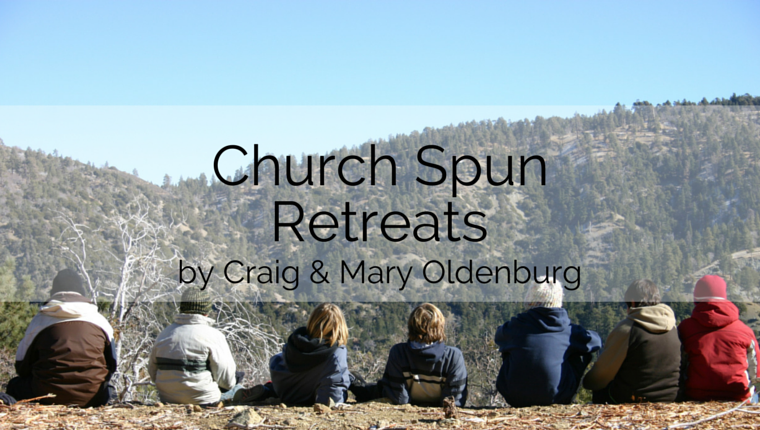What has she planned for the retreat? What retreat? Our Lutheran Church has ALWAYS had a youth retreat at Camp LutherSOMETHING every fall; and everyone at the confirmation celebration is telling Mykell, the new volunteer youth leader, how much they are looking forward to what she has planned.
“Next fall we’re going to have so much fun, Mykell.”
“When will we get to sign up?”
“Who are the other leaders coming?”
“Can I bring my friend?”
Each year hundreds of youth workers are busy planning the next great retreat and, like Mykell, they may have been on a retreat as a youth, but how exactly does one go about planning one? What if the prepackaged retreats don’t fit the group’s needs? Consider starting from scratch and developing a home spun retreat to extend the church’s mission and directly meet the needs of the youth.
By using the following eight Points of Planning, an individual or a group of planners may not only successfully work through the planning process, but develop a creative and engaging experience that will be unique to the congregation and a leave a lasting impression on the lives of youth and adults.
Points of Planning
1. Mission of the congregation
2. (Leadership Team)
3. Primary Goal
4. Dynamic Outcomes
5. Experiences that get the job done
6. Scheduling, Budget & Site Selection
7. Promotion
8. Evaluation (See #4)
1. Mission of the congregation
This first point is simple–know your congregation’s mission. The overarching goal for your retreat should fit within that mission, and the youth are a part of the mission of the congregation.
Weary leaders and new leaders are tempted to skip this first point of planning, deeming the “adult” information to be irrelevant to the youth. Something we have all been doing for decades. But as the new (or used) youth director, you have a choice of developing a culture in which youth know they are on a mission much bigger than themselves or undervaluing youth ministry because that is the way it has always been done.
Is the mission of the congregation the Great Commission? “Go therefore and make disciples of all nations, baptizing them …” Then your primary goal (see below) might include going or discipleship1 or baptism. More on this later when we discuss the primary goal of the retreat.
2. (Leadership Team)…in parenthesis, due to its ongoing nature
Choosing a leadership team really depends on your primary goal, outcomes, experiences, and promotional needs. Youth ministry leaders do not have to do the planning alone–and actually should not do it alone. They will select leadership who fit the needs of the participants, the needs of the program, and finally, the needs of the site.
You might begin by choosing one or two others who will work with you on developing the primary goal and outcomes for the retreat. If you have too many people, you may never accomplish your goal. They should be people involved in the lives of youth, not just “Yes” people who agree with everything you say. They may or may not be youth–it depends on the nature of the decision being made and the maturity of the youth.
You will need to select additional leaders who have the skills and gifts to meet the needs of the retreat. As a result of your planning, you may have chosen unique experiences, a particular site, or perhaps you need a certain type of promotion. Select leaders who will be an asset to the team and have the ability to assist with these needs.
You can add leaders throughout the planning and implementation process.
3. Primary Goal
Whether you have a leadership team or not for this point of planning, you need to begin with this critical step if you are going to create a lasting impression in the faith and life of youth (and adults).
We can agree that Jesus had primary goals when he sent out or went out with His disciples. And He used some wily methods to achieve those goals. Good goals save a lot of time in planning and allow for a more creative process.
If you want to leave a lasting impression–make sure that you are intensely focused on one primary goal during planning. Other goals will be met. In almost all retreat settings it is probably fair to assume that:
-
Relationships will be built
-
The Holy Spirit will be changing hearts
-
Friendships will be established
-
Youth will be prepared to share their faith in their community without fear but possibly with rejection.
-
Youth will train and become equipped with skills to make this summer’s mission trip more focused and dynamic so they can hit the ground running.
-
Youth will grasp the grace perspective of the 10 commandments (and we would like to add)…and be able to share that perspective with others.
This goal is the ONE BIG EXTRAVAGANT IDEA. It can be abstract. It can seem unattainable. Don’t be afraid to be a little outrageous. But think bigger than just having youth make new friends. Remember, the church is about reconciling the world to Jesus. Think BIG!
4. Dynamic Outcomes2
You should remember two things when developing dynamic outcomes for your retreat:
-
A good outcome is freeing to the planning process and is the catalyst for the most creative experiences.
-
Outcomes simply describe what participants will be like after the retreat experience.
Focus on how youth will look, how they will behave, what skills they might have when the retreat is over.
Many leaders will use a version of the S.M.A.R.T. acronym to help them develop outcomes what will be true when the retreat is over:
S Simple
M Measureable
A Attainable
R Realistic
T Timely
Well, what will be true when the retreat is over? Using one of the Goals listed above…
Youth will train and become equipped with skills to make this summer’s mission trip more focused and dynamic so they can hit the ground running3.
…construct only two or three S.M.A.R.T. outcomes. You will want to leave room for a variety of experiences (see below) to help make the outcomes stick. Know that you must approach each outcome from a multitude of directions.
-
Sample outcome 1: Youth will know how to build a wall.
-
Sample outcome 2: Youth will know how to spend 10 minutes alone with God, praying and discerning His Word.
-
Sample outcome 3: Youth will know how to do two of the following:
-
Cook a culturally appropriate meal for 10 people.
-
Swing a hammer safely.
-
Safely use a circular saw for cutting.
-
Play and interact with elementary age children in culturally appropriate ways.
-
Ask questions that lead to understanding who Jesus is.
-
Now evaluate my outcomes: Are they simple? Measurable? Attainable? Realistic? Timely?
Why approach each outcome from a multitude of directions? This supports the learning styles or heart languages of the youth and adults involved in the retreat.4 It supports the life circumstances each youth is facing at home or school. It also can provide a challenge for youth accepting the idea of being stretched to grow.
5. Experiences (that get the job done)
You have a solid primary goal. You have two or three dynamic outcomes. Now create experiences that will tend to produce those outcomes.
Many retreat planners begin with a “great activity” when they plan a retreat instead of with a goal and outcomes. By starting this with an activity, they miss the opportunity for this very creative time in the planning process. Take for example one of the outcomes listed above:
Sample outcome 1: Youth will know how to build a wall.
How many different ways could you build a wall on a retreat? Could you have a blindfolded team build a wall using branches? Or build a wall using bricks soaked in dish soap? Or by using balloons and duct tape–make the world’s largest balloon wall house–then gather inside for a discussion about God’s breathing life into His people. Could you build a wall a camp actually needs? And what about having a wall carrying competition? Or incorporating a discussion on emotional walls we build around us? Maybe a camp needs a wall to be torn down.5
Remember, a good outcome is freeing to the planning process and a catalyst for the most creative experiences.
6. Scheduling, Budget & Site Selection
For many youth ministry leaders, this is the only point of planning they ever use. But you, you are much wiser than those leaders. You only set a schedule, figure out financial needs (budget), and choose a fitting site after you have a complete foundation based on a goal, outcomes, and experiences. You are a youth leader of distinction.
Schedule, budget, and site selection should happen simultaneously. Each affects the other systematically.
Once a leadership team has a clear set of experiences listed, they should begin to think of the retreat sites that would best facilitate the experiences. Consider the camp staff, the grounds, available equipment, the weather (do lakes or mountains cause weather that helps or hurts the outcomes?), the distance, the food, sleeping accommodations, etc.6
You can quickly see that your decisions on a site will affect the budget. What can you afford?
Note: When it comes to fundraising for a youth event and you believe your event will cause youth to return to be more effective in their community, state your point to local businesses and see if they will help to sponsor part of the retreat. Be ready to show measureable results (which are often facilitated by good outcomes). Don’t limit yourself to a mediocre retreat because of funding if you know you have an important goal and truly dynamic outcomes that will make a difference in your community.
The site you pick will affect your schedule. How close are things to one another? Are there quiet times scheduled during the retreat? When are meals and can the times be changed? When is staff available? Can the site support your theology?
7. Promotion
This is not our area of expertise, but keep these three points in mind:
-
Fully disclose what is going to happen at the retreat in your promotion. No surprises. This is an ethical issue. Share the schedule. Cost. The kind of food that will be served. Everything. Youth need to be able to make a good decision–know if they are sacrificing, if they could possibly be hurt–all of it.
-
Disseminate the information in as many ways as possible. Verbally (say it, sing it, record it, video tape it, etc.). In print (bulletins, special notes, postcards, etc.). Electronically (web, text, email, Facebook, YouTube, etc.)
-
Have one place where all the information is available and point to it with the rest of the promotion. By having good outcomes and experiences you have all the information necessary. Say less on each promotional piece. The more there is, the less it is read, heard, etc. (Like…did you even finish reading this article? If you did, email us at oldenburgs@hotmail.com and let us know.)
Finally, promotion includes registering youth for the event. Always charge a non-refundable deposit. A deposit is our culture’s form of commitment. In the Bible, people would cut an animal in half as a sign of commitment–or a covenant. This might not be the best way to get a commitment in our culture. So we recommend a non-refundable deposit instead.
8. Evaluation (See #4 Dynamic Outcomes above)
Get ready for next time. Evaluate. Informally and formally. Write the evaluation during the planning stage, not during the retreat.
Remember those dynamic outcomes? Isn’t that what you were trying to achieve? Evaluate those. Yes, the site is important, but what is most important is that what happened at that site caused your outcomes to become a reality. So how does a leader evaluate based on the outcomes?
First of all, have you seen youth fill out evaluations? Don’t get too serious about this process if you want to get serious answers. You can evaluate many things by simply watching to see what happens. This is informal evaluation. Then you can evaluate formally so that you have statistics. For example, a paper evaluation based on the original outcomes might look like this:
Cook a culturally appropriate meal for 10 people
Swing a hammer safely
Use a circular saw safely
Play and interact with elementary age children in culturally appropriate ways
Ask questions that lead to understanding who Jesus is
Before the mission trip, I need more training in______
Conclusion
Find out about the Lutheran camp near you and contact the staff. They may have a prepackaged retreat that fits your group’s needs, but if not, consider starting from scratch and developing a home spun retreat to extend the church’s mission and directly meet the needs of your group.
What this article does not deal with is safety. Along with several ministry professionals, we wrote a book about safety, Experiencing Safely, to help with this topic.7 This is one other essential you need to explore in depth as you plan a retreat.
By using your local Lutheran camp you often gain access to professional help in planning your retreat and guaranteeing an appropriate level of safety (risk management) for your event. Most of the camps provide this at no charge when you use their facility. Share this article with them if they don’t know how to help you in the way you desire.
Above all, the ultimate goal (stated or not) of your retreat should be that of Jesus Christ: that people (youth) would know God in the fullness of Jesus.
-
To be reconciled to God in Jesus for the expressed purpose of going and making disciples of all nations.
-
To care for the widows and orphans of our times.
-
To know forgiveness in Christ alone.






0 Comments